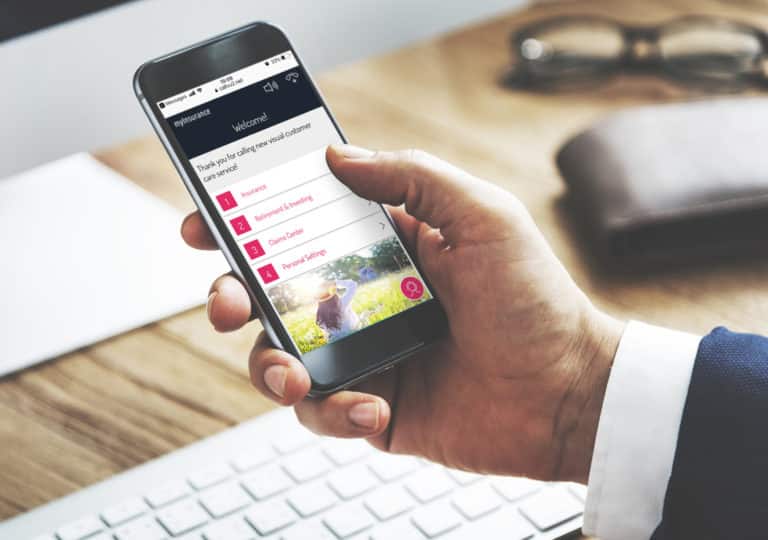What if you could divert contact center calls by 50%, 70%, or even 90%? For many companies, that would translate to:
- Multi-million dollar customer support cost savings
- Near-total elimination of call wait times
- An end to agent shortages and recruitment challenges
Leading banking, lending, telecom, insurance, and healthcare companies are achieving massive reductions in total customer service call volumes by deploying digital self-service micro-apps to help customers address their challenges at a fraction of the cost of live human support.
Perhaps even more gratifying is that along with those savings and reduced headaches for the business come INCREASES in net promoter scores, CSAT ratings, and customer loyalty metrics. This post provides a blueprint on how you can divert contact center calls and bring these benefits to your organization quickly and cost-effectively.
Contact Center Challenges
Contact centers were originally established long before digital provided additional options for resolving customer challenges. When they first materialized decades ago, contact centers gave customers a means of resolving their issues without going to a retail location or office. That made them convenient alternatives for customers.
As contact centers started receiving more incoming calls, costs spiraled, and it became increasingly challenging to maintain a full complement of agents. In 2021, the average cost for US-based contact center support reached about 98 cents per minute of connected time. When even the most straightforward requests involve minutes spent verifying identity and getting needed information from the customer, it has become common for calls to average >$10 each. While overseas contact centers can offer less costly cost structures, they sometimes lead to higher customer frustration as callers struggle to understand foreign accents and hear representatives through poor VOIP connections.
Shortages of agents and high service costs have led to long waits on hold for many customers, which can be frustrating and drive many of your best customers to abandon before they receive satisfaction. This puts a significant portion of your business at risk. Bad customer service experiences are a primary driver of reduced customer retention.
Empowering the Digital Customer
Fortunately, digital technology gives us many new ways to empower customers to resolve their issues with self-service experiences that deliver answers more quickly and create higher levels of customer satisfaction. Digital has so transformed how we interact with people and businesses that many customers now prefer using low-cost self-service solutions to relying on human support. If we can give customers easy access to self-service experiences, most will choose them over placing contact center calls.
But while solutions like full-featured mobile phone apps and customer portals can meet some customers’ needs, many companies still receive lots of calls for straightforward requests because customers find it easier to pick up the phone. To help make it easier to deliver simple customer experiences for straightforward requests and make them available whenever and wherever the customer might want them, many companies are turning to micro-apps.
Micro-App Advantages
Micro-apps are simple applications designed to enable customers to perform a single task quickly and easily.
SCREEN SCREEN SCREEN
Their focus on one task and simple designs make them an ideal way to get more customers to choose digital self-service over contact center calls:
- Simple Workflows: Micro-apps deliver the simplest engagement possible to the customer. There are no places for the customer to get off-track, and their design minimizes the possibility of confusion.
- Fast Answers: Micro-apps enable customers to get specific information quickly, often in less than a minute. By contrast, many contact center engagements require hold times of ten minutes or more before the customer is connected.
- High Portability: Well-designed micro-apps are not limited to being delivered in a single channel. The customer is presented with a short link. Clicking redirects them to a secure web page and the experience.
Micro-apps give customers the straightforward experiences they want and the ability to access them anywhere. That maximizes adoption and call diversion/deflection.
Delivering Micro-Apps
Because micro-apps are delivered to customers via a short link, they can be embedded into web pages, customer portals, account profiles, mobile apps, and on-premise kiosk interfaces, often preventing the customer from ever picking up the phone. Further, one positive experience with micro-app conditions the customer to seek out more of these straightforward experiences in the future, instead of making an incoming call.
Micro-apps can also be offered in audio IVR workflows, diverting even more callers before they ever need to speak to an agent. Here’s how:
- The customer places a call that is answered via IVR
- The IVR offers the option to resolve their issue more quickly by receiving a secure form on their mobile phone
- Customers who opt-in receive a link via SMS text. Clicking the link redirects them to the micro-app on a secure webpage.
- The customer exits the contact center queue and resolves their issue via digital self-service
By helping the customer resolve their issue more quickly and easily, you not only prevent an expensive live telephone engagement for your inbound call center but also drive higher customer satisfaction. This is truly a win-win for both the company and the customer.
TYPICAL CALL DIVERSION RATES
FICX has worked with companies in various industries to help divert contact center calls with micro-apps. Typical results are that 30% of calls for the use case can be prevented in year one, rising to more than 80% by the end of year two. The more channels you equip with your micro-app experience, the higher the diversion rate.
In almost every case, customer satisfaction ratings and net promoter scores rise in direct proportion to the diversion rate. Customers value these faster and easier customer experiences over waiting for a live agent.
Some customers are more likely to avail themselves of digital self-service than others. Younger, more digitally savvy users adopt these experiences more readily than others, but even that is changing as more digitally adept individuals age.
Example Micro-App Use Cases
micro-app adoption is highest among companies in the Banking, Lending, Insurance, Healthcare, and Telecom industries. Here are six of the most common customer interaction tasks that are being addressed with micro-apps for each of multiple industries:
BANKING
- New Customer Onboarding
- Check Balance
- Transfer Funds Between Accounts
- Set Up AutoPay
- Request a Credit Increase
- Make a Payment
LENDING
- New Customer Onboarding
- Check Balance
- Apply for a Personal Loan
- Make a Payment
- Change of Address
- Set up AutoPay
INSURANCE
New Customer Onboarding
- First Notice of Loss Claim
- Sell Insurance Bundles
- Life Changes
- Adjust Coverages
- Document eSign
HEALTHCARE
New Patient Profiles
Medical Histories
Anesthesia Release
- Make a Payment
- Request an Appointment
- Request for Prescription Refill
TELECOM
- New Customer Onboarding
- Change of Account Ownership
- Make a Payment
- Change Plans
- Temporarily Add International Calling
- Address Change
Developing Micro-Apps
Some companies build their micro-apps using their internal development teams or outsource to other development companies. The challenge is that most organizations have a shortage of dev resources. CX projects must compete with all other company initiatives for resources. Many CX and contact center leaders find their projects languishing in the dev queue.
More recently, no-code platforms have become popular for developing and deploying micro-apps. A no-code platform enables a user to drag and drop the elements of a customer experience without knowing code. This reduces dev time by 10X and costs by more than 90%. No-code platforms also make it easy to connect your new experience to existing internal platforms like your account manager, ERP, payments portal, etc.
Once created, the experience is integrated with your internal systems and processes with pre-built connectors. From there, it is ready to be deployed across the various channels and touchpoints. No-code platforms are at the center of the deflection strategy for many leading companies today.
Getting Started
If you are interested in learning more about micro-apps and developing them for your business, learning more about the FICX No-Code CX Automation Platform is a great palace to start. Our robust solution enables you to create, connect, and deploy micro-apps 10X faster than via custom or outsourced development. Our drag-and-drop interface, pre-built and API-based connectors, and omnichannel capabilities help leading companies deliver millions of digital self-service experiences daily. Find out more, or request a demo now.





